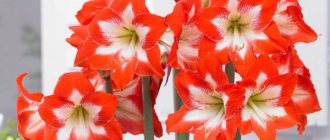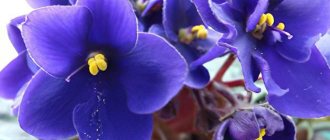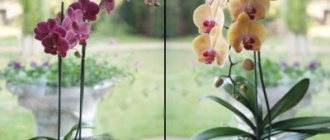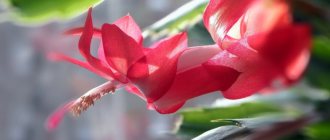Contents in the apartment
Not all gardeners have a spacious cellar to store their favorite cannas. In this case, storing tubers in winter can be done directly in the apartment. To do this, use one of the following methods:
- Storage in pots.
- Cold storage.
- Storing as a houseplant.
If the first option is considered, then it has several differences from storage in the cellar. As soon as the first night frosts begin, the flower must be cleared of dead leaves and dried flower stalks, and then placed in a pot with soil. This method is suitable for keeping culture in the attic, closed loggia and even in an apartment. In the latter case, you need to find a cool space, preferably near a balcony door, away from the heating radiators. Watering the plant is carried out once every 1-1.5 months.
Advice!
Closer to spring, the intensity of such procedures can be increased so that the flower has time to “wake up” from winter sleep. And half a month before moving the flowers into open soil, they need to be fed with a special fertilizer.
When storing cannas in the refrigerator, you can follow a simple preparation principle. To do this, you need to trim the flowers and stems by 5-10 centimeters, and then treat the cut areas with iodine. After digging up the root system and rinsing it with running water, they need to be immersed for a day in a solution of potassium permanganate or a special disinfectant composition, which can be bought at a flower shop.
After 24 hours, the flowers can be removed from the container with the solution and then dried. After this, they need to be wrapped in damp newspaper and closed in a plastic container, which should eventually end up in the refrigerator. You need to make several ventilation holes in the containers.
Once a month, it is necessary to open the container and check the canna root system for rot or drying. This method is suitable for owners of several refrigerators or a small number of flowers, since storing them requires a lot of space. At the beginning of April, the tubers are taken out of the chambers and prepared for the upcoming planting.
You may be interested in:
Late flowers: names of autumn plants for flower beds Autumn is the time when everyone around is preparing for the cold: people are harvesting crops, making preparations for the winter, taking out warm clothes and...Read more...
Reasons for popularity or why cannes are so in demand
cannas can be planted individually or added to a flower arrangement
When choosing which flowers will be the best and undemanding decoration for a flower garden, be sure to take a closer look at the cannas. It’s not for nothing that they are the favorites of designers when decorating city flower beds; they are planted as a separate plant or as part of compositions. There are several reasons for these magnificent flowers to appear on your site:
- Plants are undemanding and do not require special care. They practically don't get sick. They are not afraid of pests. They can easily tolerate short-term drops in temperature. They are drought-resistant plants.
- The flower amazes with the beauty of the inflorescence. Its beautiful large shape will definitely become the center of attention of the flower bed and flower garden.
- Canna has a long flowering period: about two months it will delight with large flowers beautifully collected in inflorescences.
- A flower decorates a flowerbed not only due to its inflorescences. Currently, there are plants with beautiful decorative leaf shapes that look great in the garden.
- The plant itself is distinguished by a thick, fleshy stem up to 2 m high. The straight shape fits beautifully into the floral ensemble. And the strong stem can withstand wind loads.
Kanna: appearance
unusual two-color canna flower
As noted, canna is a large plant with a thick, straight stem that does not need to be supported. An adult healthy flower is capable of throwing three to four arrows. The height can be from half a meter to two. These sizes allow the flower to be grown both in the ground and in flower pots. There is no significant difference in care. Here are some features of canna:
- Cannas are perennial plants. Their heat-loving nature is incompatible with the cold Russian winter. Therefore, when overwintering in open spaces, the plant most often dies.
- A feature, and some consider this property a disadvantage, is the lack of odor.
- The flower blooms four months after the start of shoot development. Flowering begins in July and lasts about two months, or even until the first frost.
- Canna is a large flower from 3 to 15 cm in size, reaching 30 cm in inflorescences, painted in any shades of yellow, red, burgundy and orange. 10 mm is considered standard. Most often colored red, yellow shades are less common. The snow-white color is unique. It can be either plain or dotted or striped.
- The canna stem has large, oblong, elongated leaves that are significant in size. Can be up to 80 cm.
delicate Salmon Pink canna flower
Cannas are heat-loving plants, so they do not like early planting in open ground. But it is also worth considering the fact that the sooner a flower begins to develop, the faster it will bloom and begin to decorate the flowerbed. Therefore, for planting, a technique is used in which the flower is germinated in advance and thereby artificially helps to begin flowering earlier.
Canna: most common varieties
there are more than 50 varieties of cannas
Cannes are very popular flowers that are loved by collectors. Currently, the trading network offers a large number of beautiful varieties, differing in the size and color of the flower, stem height, and decorative features of the leaves. Even the most demanding lover can find a variety that will satisfy his most sophisticated needs.
The following varieties are most widespread:
- Indian eland is one of the most common and unpretentious. Easily grown in garden beds. It does not require special care. It belongs to the dwarf varieties, its average height is just over half a meter. Perfect for forming borders. Planted in containers located around the site, it will decorate any suburban space with its excellent appearance. The leaves initially have shades of soft green, which gradually darken during the summer. The plant compensates for its low growth with its stunning colors and appearance of inflorescences.
Canna flower: planting
Before planting, canna tubers are divided into several parts
Cannas are a favorite plant of both urban landscape design specialists and owners of country estates. Depending on the climate, the plant is planted both in open ground and seedlings are pre-grown in a greenhouse.
Before planting the plant, inspect the roots. They are divided into several parts. Pay attention to ensure that one or more strong buds remain on part of the rhizome. Adjacent buds are left together and not separated.
The separation areas must be processed. For disinfection, use crushed coal powder or a solution of potassium permanganate.
the first sprouted canna leaves in the apartment
Canna flower: planting and care in open ground
Plants are planted in open ground in the southern regions. Places chosen are sunny, protected from the north side from the wind. According to the time of year, this is the month of April. There are no special requirements for the soil. It should be loose and prevent stagnation of water, drain well, and be sufficiently fertilized. First, a groove is dug in the ground. The depth is no more than 10 cm. Plants are placed at a distance of up to half a meter. Cover with a layer of earth.
canna propagation by dividing rhizomes
Care involves periodically watering the plant; abundant watering is especially important during flowering. A few days after watering, the soil needs to be loosened a little, while weeds are removed. Periodically, as the plants fade, the shoots and wilted inflorescences are removed. This gives the plant a well-groomed appearance and stimulates the flower to produce new shoots.
Canna flower: planting and caring for seedlings
after the first sprouted leaves appear, the cannas are transplanted into separate pots
Growing seedlings is one of the most popular and most widespread methods:
- To begin with, the rhizomes are sorted and divided into parts. The cut sites are processed.
- The roots are dried a little.
- Place in a container and cover with calcined sand.
- Watering is done every other day.
- The roots grow best on the sunny sides of the apartment, especially if the container is located above the radiator and is constantly in a heated state.
- With proper planting and care, the plant sprouts in two weeks.
- After the leaves appear, each plant is transplanted into a separate container, where it continues to grow as a seedling.
cannas should be planted in a sunny location
This method of growing through seedlings is the most successful and allows you to get a strong plant capable of long-term flowering. In a cool climate, when planting an unsprouted rhizome directly into the soil, the plant may not have time to bloom.
Seedlings are planted in the soil no later than the end of May. During this period, the soil should be well warmed up and there should be no threat of frost returning. By this time, the seedlings should have grown significantly and become stronger.
canna is planted in open ground in mid-May
Plant the plant in well-fertilized soil. Organic substances or mineral mixtures are used as fertilizers. In order to accelerate plant growth, various agricultural techniques are used. The most widely used method is to create warm conditions.
cannas are quite large plants, so they are planted at a distance of 60cm
Growing canna with natural soil heating is carried out in the following sequence:
- The main requirement is good soil preparation. To create a warming layer, the top part of the earth is removed. A ditch 70 cm deep is dug.
- The first layer is placed on the bottom of the ditch with hay or a small layer of rotted manure.
- Part of the earth is poured. The soil layer must be at least 25 cm.
- The seedlings are being installed. When planting, the stem is not covered with soil; the growing point remains open, on the surface.
- The planting depth of the rhizome is 15 cm.
Subsequent care includes watering once every 10 days. Water the plant with root broom. Fertilizers are added periodically to stimulate growth. During flowering, abundant watering is required.
Canna flower: growing by seeds
Indian canna seeds
If during flowering the inflorescence is fertilized, then seeds appear. They can be used to grow a new plant. The effect will not be quick; this type of reproduction has its own difficulties. But this method of cultivation is also used. In order to speed up the process of propagation by seeds, you should adhere to the following recommendations:
- It is necessary to start planting seeds for seedlings as early as possible; the best time is January or early February.
- In order to speed up the germination process, the seeds are first thoroughly cleaned with sandpaper. The hard and dense skin of the seed prevents it from growing quickly and makes germination difficult.
- Next, the seeds are immersed in a regular plant growth-stimulating solution for a day.
- Plant the seeds in fertilized soil. Grow seedlings in regular soil for indoor plants.
- After planting, the container is transferred to a warm place. The plant begins its development from seeds only after the air temperature reaches 25 degrees.
- If planted correctly, seedlings appear within four weeks.
- After the second leaf appears, the plant is picked and transplanted into a separate container for further development.
collecting canna seeds
There is another way to destroy the integrity of the seed coat before planting seedlings. The seeds are left in the refrigerator for several hours, scalded with boiling water and kept in warm water for three hours. Then the seed is lightly pierced or cut.
Planting with seeds is recommended if you want to have flowers of amazing color and shape on your site. This is due to the ability of canna to not retain through seeds the characteristics inherent to its species.
Canna flower: planting and care in the apartment
canna rhizomes awaken in a warm greenhouse
The plant is successfully used to decorate the space of an apartment. Growing in artificial conditions is carried out taking into account the following specific requirements:
- A plant grown in an apartment needs rest. It lasts 2 months. At this time, cut off the tops of the stems, leaving small cuttings up to 15 cm. The temperature should be about 10 degrees.
- Low-growing plants are well suited for growing at home. Planting is done in large pots. The plant does not need tying.
- In order to obtain large inflorescences, the first peduncle is removed. At the same time, the root system is strengthened.
- When germinating at home, canna needs abundant feeding with fertilizers.
- Spraying is not used for home flowers. Before it rains, the plant itself releases moisture on its leaves and can be used to forecast the weather.
Canna flower: forming a flower bed
cannas will decorate any flower bed
The flower itself is very large and can decorate any flower garden. Therefore, it can be planted alone. In order for compositions to look advantageous, experts advise maintaining proportions. Place large plants in large flower beds and, conversely, plant low-growing ones in a small space. A flower bed looks beautiful if several varieties are planted nearby, differing in color and height:
- The decorated space gets a beautiful look if the plants are placed along the fence, against the backdrop of verandas, outbuildings, or a house.
If a tall variety is used for the design, it can be placed in the center of the composition or in the second row. In front, against the background of large leaves, you can place other groups of plants. cannas are an excellent choice for edging a path - Cannas are used to frame, highlight, or hide from view any parts or plants of an area. In this case, when planting, they are placed densely and planted in the form of a fence.
- Low-growing varieties can be safely planted in flower pots and used near the house or as decorative elements for a personal plot. They look very picturesque due to the colorful leaves, thick stems and large inflorescences, especially considering that flowering lasts a very long time.
cannas as a central element in a floral arrangement
- Compositions made in a flower garden in several levels look beautiful due to the combination of low-growing and tall varieties.
- Canna varieties of variegated colors planted nearby will look beautiful, like multi-colored strokes, not only during flowering. Coloring the leaves of plants planted nearby in a flower garden in different colors will be an additional decoration.
Cannas look good and decorate the flower garden not only in the daytime; a lamp located nearby will emphasize the high colorful shape of the plant at night and in the twilight period.
How does Canna survive winter outdoors?
In Russian conditions, eland can winter only in the southernmost regions of the country. In the rest of the territory, the flower is dug up for the winter and stored in a dry basement.
Preparation for winter begins in September, when the base of the canna stem is covered with soil to a depth of 15 - 20 cm. This measure will protect the roots from rotting.
The plant is dug up after the first serious frost, which will kill the above-ground part. The stem and foliage of the canna are cut off, and the root is dug up and placed in a pot or bucket.
Canna storage temperature is + 5 + 10 degrees. During the winter, the earthen ball is periodically sprinkled with water. The humidity of the soil in which the tubers are located should be about 50%.
Which varieties are suitable for home cultivation?
There are special varieties for growing indoors that do not grow as large as outdoor varieties.
Homemade canna varieties:
- Livadia is a bush up to 1 m high. The inflorescences are scarlet, large. Up to 25 cm in diameter. The foliage is large. Flowering begins in July.
- America - the height of the stem is 1.2-1.4 m. The petals are red in color, 10-14 cm in diameter. The flowering period occurs in the second decade of July.
- President is a bush up to 1 m high, scarlet inflorescences, 14-17 cm in diameter. The foliage is rich green in color. The flowering period begins in July.
- Richard Wallace - a bush up to 1.2 m high. The petals are yellow with red-brown dashes. Flowering begins in early July.
- Suevia is a plant up to 1 m high. The inflorescences are of a rich yellow hue. The flowering period occurs in the second half of July.
- Andenken an Pfitzer - stem height is 1-1.4 m. The inflorescences are orange-yellow with red dashes. The length of the inflorescence is 30 cm. The foliage is rich green.
- Cleopatra is a low-growing variety up to 1 m high. The petals of the inflorescence are yellow with scarlet stripes.
- Orange Magic - the height of the stem is about 80 cm. The shade of the petals is peach. The inflorescences are small, 7 cm in diameter.
Even homemade canna varieties are never less than 1 m. On average, the height of varieties for growing at home ranges from 1-1.4 m.
Flower propagation methods
The plant can reproduce in several ways. The choice of propagation method depends on the personal preferences of the gardener.
Rhizome division
One of the simplest methods of culture propagation. To use it is necessary to prepare a root on which there will be shoots. The root is divided into several pieces. Each segment must have at least 2 buds. After the root is divided, the cut areas should be treated with manganese or wood ash.
Parts of the rhizome are placed in a warm place to awaken. Once every 2-3 days, the roots are sprayed with warm water. Parts of the root must be placed in a mixture of peat and sand for two weeks. This period is enough for additional root shoots to develop and the bud to sprout. The sprouted root parts are placed in open ground and covered with plastic film. To ensure that the flower does not have to be replanted, when planting in the ground, a distance of at least 60 cm is maintained between the holes.
Seeds
Propagation of cannas by seeds is very rarely used and can contribute to the appearance of new colors and forms of the plant. In order to plant a flower in open ground in spring, the seeds should be germinated. Seeds can be purchased at a special store or collected yourself. The seeds are collected after the plant has completely flowered and formed a seed pod. The seeds are large in size and have a hard shell. Without pre-soaking, they rarely sprout.
After the planting material is treated with boiling water and placed in the ground, it is necessary to regularly water the holes. Seeds are planted in pots and only after seedlings appear, they are planted in open ground.
Cannas are one of the unique flowers that can be used to decorate the garden. The plant requires compliance with certain rules of care, otherwise it is often affected by diseases and pests. Cannas can be grown not only in open ground, but also at home. The care process is no different, but the flower is large and takes up a lot of space, which often causes discomfort.
A few words about the plant
Canna is a monoculture, i.e. the only representative of the horse family (Cannaceae). Under natural conditions, it grows in South and Central America, China, Indonesia, and India.
The flower has thin, erect stems that grow up to 3 m in height in some varieties. The leaves are lanceolate or oblong, quite large, and can grow up to 80 cm in length and up to 25 cm in width.
Canna reveals its splendor when flowering. The main color of its buds is red, although breeders have managed to develop varieties with yellow, white, orange, pink and even two-color petals - speckled or bordered. The flowers grow up to 8 cm, they are bisexual, asymmetrically located on the flower shoot and collected in an inflorescence - a panicle or raceme.
The flower has only two drawbacks: it does not tolerate our winter outdoors well and has no smell. Among its advantages, gardeners highlight the following:
- very rarely gets sick;
- grows quickly;
- easy to grow;
- easy care;
- decorates the area with its flowering until late autumn.
If the buds have been pollinated by insects, large brown seeds have time to ripen. They can be used for reproduction.
Is it possible to keep the plant in the house?
Fuchsia in the house is a kind of talisman of well-being and success. It charges household members with positive energy, joy, love of life, drives out bad moods and irritation, thereby reducing the number of quarrels and conflicts.
The benefits of an indoor flower
The plant helps people find a common language, fills the atmosphere in the house with mutual understanding, support, and mutual respect.
Fuchsia is especially indispensable where a large family of several generations lives under one roof. The flower eliminates resentment and alienation, allowing everyone to feel needed and loved.
If the plant is in the house for a long time, its owners develop intuition, and in some cases, the gift of clairvoyance.
The owners of the flower recover strength more easily and quickly after heavy physical or psychological stress, and release accumulated negative energy. To do this, it is enough to be near the fuchsia even for a short time. In addition, the plant gives household members endurance and performance.
How can it be dangerous?
Sometimes there is an opinion that fuchsia is a widow's flower. It is also called widow's tears. Some particularly superstitious people believe that the plant drives men out of the house. However, there is no explanation on what this negative idea of the plant is based. Each gardener will have to decide for himself whether to have fuchsia at home or not. But most flower owners do not pay attention to this superstition, considering it false.
Storing canna in the apartment in winter
If it is not possible to place the plant in a cellar, basement or loggia for the winter, you can store it directly in the apartment. To do this, you need to dig up the whole flower at the end of September, before the onset of cold weather, without cutting it. The lump of earth must be left along with the roots. Next you need to transplant the canna into a flower pot.
The flowerpot should be large and spacious enough. This will allow the root system of the flower to develop normally. After replanting, the soil should be thoroughly watered with a solution of potassium permanganate, this will allow it to be disinfected. The plant needs to be moved indoors.
With this storage, the plant will continue to flower until mid-winter, then shed its foliage and go into a dormant state. Dormancy when storing a flower at home lasts no more than two months. Then the flower begins to grow, and with the onset of consistently warm weather it can return to the garden again.
Also, when stored indoors, canna requires more frequent watering, because the air is usually very dry in winter. Once a month you need to fertilize the plants with complex mineral fertilizer.
Why do cannes need to be dug up for the winter?
As with most tropical plants, sub-zero temperatures are detrimental to cannas. Therefore, in order to preserve these beautiful plants, they should be dug up every autumn before the onset of cold weather and planted again in the ground in the spring, as soon as warm weather sets in.
Cannes are recommended to be dug annually.
In the southern regions, where the soil temperature in winter remains between 0 and -5 degrees, plants can be left to overwinter in the ground. At the same time, they are covered for the winter, for which they should:
- trim flower stalks and leaves to the base;
- lay down spruce branches or add a layer of pine needles;
- Drive pegs along the edges of the protective area and lay mats on top of them;
- fix them securely.
If the soil temperature in winter drops below -6 degrees, the cannas must be dug up in the fall before frost sets in and stored until spring. The first night frosts in the fall can serve as a signal to start work, but especially valuable varieties can be dug up in mid-September, without relying on the vicissitudes of the weather.
For northern regions, it is recommended to dig up flowers from open flower beds in late August - early September. It is not advisable to miss deadlines in order to prevent the roots from freezing and rotting during storage.
Digging dates should not be missed to prevent the roots from freezing.
Types and varieties of cannes with names and photos
The progenitor of almost all types of cannas. The cultivated varieties of Indian canna obtained as a result of selection are called garden canna. These hybrids are divided into three groups.
Cannes Crozy (French canna)
They are considered a low-growing species (60-160 cm), their flowers are similar to gladioli. The dark green or purple-pink leaves are covered in white.
- Livadia: up to a meter in height, red-crimson flowers appear on a peduncle 25-30 cm long, the petals have a bend, begins to bloom in July;
- America: 120-140 cm high, blood-red flowers 12 cm in diameter, inflorescence length 30-35 cm, purple leaves, blooms in July;
- President: up to 1 meter high, bright red flowering on a peduncle 30 cm high, standard leaf color - green, begins to bloom in July.
Orchid cannas
A tall species with a height of 1-2 m. The flowers are large - 12.5-17.5 cm with thin corrugated edges, shaped like cattleyas. The leaves are green and may have a purple tint.
- Andenken an Wilhelm Pfitzer: 110-140 cm high, the inflorescence reaches a length of 30 cm, the color of the flowers is bright orange with red strokes, the leaves are brown-purple, begins to bloom in July;
- Suevia: up to a meter tall, lemon-colored flowers measuring 12 by 15 cm appear in mid-July, green leaves;
- Richard Wallace: height about a meter, flowers are light yellow with red speckles, inflorescence length is 20-25 cm, blooms in July.
Deciduous (small-flowered) cannas
They grow up to 3 m in height, the leaves are very beautiful, colored green, purple, violet-green, the flowers are small - no more than 6 cm in size, this species is rarely grown in culture.
Durban is the most famous variety of small-flowered canna. The flowers are yellow-orange, the color of the leaves is more interesting - pink-yellow-bronze-green stripes.
Preparing cannas for winter is simple and any novice gardener can do it. Basically, you just need to choose the right moment, prune the plants, dig them up and store them. Not confident in your knowledge? Then we'll look at everything step by step.
By the way, you only need to dig up cannas for the winter in those regions where the winter temperature drops below -5°C. If you are lucky enough to live in an area with warm winters, it is enough to cut off the ground part of the cannas and cover the bushes with spruce branches, straw or other mulch.
Botanical description
The canna flower can reach 2 meters in height, has large oblong leaf blades, up to 50 cm in length and up to 25 in width.
The color of the leaf blades can be all shades of green. The flowers are very large and have a lemon, pink, and purple color. These plants are most popular for growing in gardens and cottages. They are well suited for landscaping areas and areas in front of the house. Thanks to their large size, they create a unique composition. But, in addition, canna is great for growing in the garden or at home. At home it is kept in large tubs or floor pots. To grow this beautiful flower indoors, you should select the appropriate varieties, preferably low-growing ones to fit in the room, on the balcony or loggia.
Such varieties reach a height of no more than 160 cm, they do not require complex care, and such flowers will decorate not only the room, but will also look decent in an office or administrative building.
Why artificial flowers cannot be kept in the house: folk signs and beliefs of different nations
It is believed that any inanimate flower arrangement is an energy vampire. She will take away positive energy from the house, but will not give anything in return: she does not breathe, does not grow, does not release oxygen. Artificial flowers are especially harmful to a home filled with warmth and love. Such decorations, according to folk signs and beliefs, should not be in residential premises.
If you believe the signs, then artificial flowers have no place in the house
Reasons for this:
- Such flowers evoke an association with funerals and cemeteries. Lifeless bouquets are brought to the dead and they decorate graves. And in a house where people live, it’s even scary to store them.
- Their presence in the house leads to marital disagreements, quarrels, separation (if you place them in the bedroom).
- They cause diseases (artificial climbing plants, ivy, synthetic reeds) and foretell death (wax flowers).
- People who have flowers made from artificial materials in their home interior are doomed to a lonely life.
All these signs and superstitions are mainly widespread among representatives of the Slavic peoples in Russia, Ukraine, and Belarus. It is there that there is a tradition of coming to funerals with artificial flowers.
But in China and Korea, for example, they do not give fresh flowers for weddings and other celebrations. They are believed to symbolize death and funerals, since they quickly wither and die. They use artificial flower bouquets for festive occasions, believing that they are eternal. Dead flowers were used instead of living ones back in Ancient Greece, and in the Middle Ages, currently - in Italy and Spain.
What do artificial flowers mean in the light of teachings?
Eastern sages considered the artificial flower a symbol of loneliness. And the Chinese teaching of Feng Shui about the proper arrangement of the home has a favorable attitude towards artificial flowers
In it, attention is focused on the color of the flower and there is no division of flowers into artificial or natural. According to teachings, beautiful (even not real) flowers can charge a home with positive energy and create coziness in the room
Feng Shui says that beautiful artificial flowers charge the house with positive energy
It is believed that they, regardless of the material they are made of, are imbued with the energy of their creator. After all, he puts his strength, talent and soul into these works. Artificial flowers play the role of a talisman of good luck, a talisman against various misfortunes.
Do you know how to store cannas in winter?
Cannas are incredibly beautiful large perennial flowers, stunning in their variety of colors. They are not demanding in terms of growing conditions and are not fussy to care for, however, they are not so often found in the garden. Cannas bloom from mid-July until the first frost, flower height is from 30 cm to 1.5 meters.
The flower is of tropical origin, so frost is destructive for it. Canna reproduces by dividing the rhizome in early spring, in March or April. The price of a flower is quite high, so the question is how to preserve planting material until spring. There are several methods that have been tested by experienced flower growers.
Storing cannas in the cellar
After the first frost, and this is somewhere between September and October, the cannes are dug up. In this case, first the stem is cut, leaving a height of 15 to 20 cm, then the flower is dug up and dried a little under a canopy.
When digging, there is no need to completely remove the soil from the root system; it is better if the cannas are stored with a lump of earth.
The rhizome is transferred to wooden boxes and sprinkled well with humus, soil with sawdust, peat and sand. It is desirable that the soil humidity is at least 50 - 60%, and the air temperature in the cellar is 6 - 8 degrees Celsius.
At least once a month, visit your beauty and inspect the plant and provide the necessary watering so that the rhizome does not dry out. If, on the contrary, rotten areas appear, then they are cut off to good tissue. Sprinkle the cut areas with charcoal or treat with iodine. A sudden change in temperature in the cellar should not be allowed, as this can cause the rhizomes to freeze or, conversely, rot.
Dormant period in a pot
There is a second way to store cannas in winter. Before digging up the plant, trim only dry leaves and flower stalks at the very root. Plant the trimmed plant with a ball of earth in a pot. The storage temperature should be no higher than 12 - 15 degrees. This could be a cool veranda or attic, loggia. Water the flower periodically, about once or twice a month.
Kanna can also be in a lighted room near the balcony door. Under such storage conditions, the buds will ripen very well, which will subsequently produce good strong flower stalks. When spring comes, it is necessary to gradually increase the amount of watering so that the plant wakes up. Two weeks before planting in the ground, the plant is fed.
Storage with flowering
You can put it in a pot and water it normally. Then they will delight the eye with flowering until December, and sometimes until January.
Yes, they can be grown in large pots at home! Moreover, in indoor conditions they bloom almost all year round, with only a short dormant period of 1.5 - 2.5 months.
During the dormant period, the stem and leaves dry out and fall off, and new leaves begin to form in their place. When storing or growing in this way, the main thing is that the flower has enough space in the pot.
You should not forget about a sufficient amount of nutrients. To do this, you need to feed the canna once a month with mineral fertilizers or water it with nutrient mixtures for any indoor flowers.
You should not use various mash with humus, since an abundance of fertilizers can lead to the withering of the plant. Flowering canna can be transplanted into open ground. However, you should not rush, as the slightest frost can destroy the plant.
Refrigerator storage
Some gardeners store low-grade canna in the refrigerator. If space allows you, then this option should not be excluded either.
The principle of preparing rhizomes is simple: we dig them up and wash them under running water, then soak them in a disinfectant solution for a day and, after drying, store them for storage, wrapping them in newsprint. For a disinfectant solution, you can use regular potassium permanganate or various solutions from the store.
Cannas should be placed loosely in the vegetable storage compartment. The rhizome should also be checked occasionally to ensure there is no rot. This method is suitable for those who have few rhizomes, because after all, the refrigerator is not rubber.
Closer to mid-spring, the root system should be divided according to the number of shoots and planted in pots for growth. For planting, take an earthen mixture: peat, sand and black soil in equal parts. When strong shoots appear, the plant should be fed. To do this, you should take mineral fertilizers, 40-50 g. per 1 m2.
And after the frosts leave, this is the beginning of June, they are taken to open ground. The place should be sunny or partial shade, the soil should be well fertilized. Before planting the plant, water the hole generously; when the water is absorbed, you can plant the flower. Cannes will begin to delight with large and rich flowers in mid-July or early August.
This depends on the type of plant.
Care in the garden, at home
Homemade canna is unpretentious; its main requirement for a place is an abundance of sunlight. Since the plant is large and even in indoor conditions quickly grows up to 1 m, containers are often placed on the floor, not far from the window. A good place for indoor canna in an apartment is a glassed-in veranda or balcony.
For garden cannas, sunny areas are also chosen, otherwise the plant will not be able to fully show its flowering.
Spraying and watering
Canna flowers, care, cultivation, storage of which are carried out according to the principle of other bulbous and tuberous plants, do not require too much watering. The rhizomes of home and garden specimens begin to rot when soaked.
Principles of watering cannas:
- Humidification is carried out only with settled water at room temperature.
- To soften the water, it is permissible to place a bag of peat in it for several days.
- The frequency of watering is once a week. The need for the procedure is determined by the drying of the top layer of soil.
- During flowering or in hot weather, water every 3 days. When buds appear, the soil is constantly kept slightly moist.
- From the beginning of autumn, watering is reduced and reduced to zero by the time the leaves wither.
To increase air humidity, cannas are sprayed daily. When kept in an apartment with the heating on, wet towels are placed on the radiators.
Top dressing
To feed bright, abundantly flowering cannas, you can use standard, universal mixtures. Experienced gardeners alternate such fertilizers with solutions of wood ash, potassium permanganate, humates and biological products. The usual frequency of feeding is once every 2 weeks.
Of the complex formulations for flowering crops, gardeners recommend the following preparations:
- Kemira;
- Mister Color;
- Agricola.
Mineral fertilizers are often used for garden cannas. Starting in spring, the bushes are fed with nitrogen, phosphorus and potassium mixtures. During flowering, the proportion of phosphorus-potassium fertilizers is increased and the presence of nitrogen is reduced.
For the brightness of the leaves and additional foliar feeding, the same compositions are diluted three times and sprayed on the bushes.
Trimming
The growth characteristics of cannas do not imply any formation. The stems grow harmoniously and do not require pruning during growth.
When pruning, faded flowers are removed
Faded inflorescences are cut off
Only completely faded inflorescences are cut out, wilted buds are plucked out and dried leaves are removed. In this way, they maintain the decorative appearance of both home and garden cannas until the fall.
The above-ground part is completely cut off before preparing for the dormant period. Only small sections of stems are left above the soil. Do the same before digging up the rhizomes for the winter. After flowering, domestic cannas are shortened to 15 cm.
Any instrument should be sterilized before pruning , otherwise the cannas may become infected and not come out of the dormant period.
Transfer
Indoor cannas are vigorous flowers and require annual replanting. The root system of the plant quickly masters the provided capacity. Every year the pot is replaced with a larger one. If it is not possible to increase the living environment of the canna, the roots are shortened, the bushes are divided and allowed to reproduce.
Cannas are transplanted together with a lump of earth
Rules for transplanting adult cannas:
- Transplantation is carried out in the spring, before the buds appear.
- The plant is removed from the pot by transshipment, after thoroughly moistening the earthen ball.
- The roots are inspected and rotten, darkened, rotten areas are removed.
- If it is necessary to propagate the variety, separate large bulbous nodes or divide the root into parts.
- Dip the rhizomes into a weak solution of potassium permanganate and place them in a new pot with fresh substrate.
An extraordinary transplant may be required if the plant withers for no reason or traces of parasite activity are found.
Optimal conditions
Cannas, care, cultivation, storage of which in proper conditions quickly transform the plant into strong, dense bushes, require room temperature for normal development. All stages of canna growth and reproduction are excellent at temperatures from +20 to +24 °C.
The exception is the necessary period in late autumn - early winter, when the plant is gaining strength for the new season. At this time, it is advisable to place the cannas in a room with a temperature of up to +10 °C. Rhizomes dug up in the garden can be stored in a slightly moist substrate at a temperature of +5 °C.
The air humidity required by cannas for normal growth is close to optimal conditions for humans. Bushes react to excessively dry air by curling the plates or yellowing the tips. In this case, you should spray the crown more often and place the plants on trays with damp moss.
Luxurious greenery and numerous flowers will delight the gardener only if the cannes are fully illuminated during the day. In open flower beds, plants quickly become decorative and continue to bloom longer.
Homemade cannas do not have to be placed on the windowsill. Typically, the size of the pot allows them to be grown either on the floor near a window or on a glassed-in balcony.
Where is the best place to place the plant?
It is better to grow a flower in the office - this is the most harmonious place for it. It will have a beneficial effect on the work team and will help in moving up the career ladder. A pot with a plant in the house should only be placed at the entrance door. Then he will be able to protect the home from unwanted guests with bad intentions.
Since the house loach is not associated with the most favorable signs, it is better not to keep it in the apartment. The ideal place for it is a flower bed or fence. There the plant looks beautiful and protects the home of its owners.
Whether or not to believe in the signs associated with ivy, everyone decides for himself
It is important to consider that problems are not always caused by a flower; often the person himself is the cause. In any case, ivy requires special care and does not tolerate being neglected.
Cannes: diseases and pests
increased moisture in the rhizome can cause fungus
Despite the fact that cannas practically do not get sick and are too tough for garden pests, as exceptions, such troubles with flowers do happen. Most often they are associated with poor soil drainage and the resulting increased root moisture. The following diseases are distinguished:
- Bacteriosis manifests itself as black spots on flowers and leaves. Most often, a flower lover will not be able to overcome the disease. It is recommended to remove the diseased flower from the garden bed.
- Rust damage causes red spots on the leaves and a gray rotten coating on the flower. It is enough to remove the affected plant fragments and burn them to prevent re-infection.
- In order to get rid of caterpillars, special means are used. Processing is carried out in the order suggested in the instructions.
- Yellow leaves indicate excessive fungal activity. In order for the plant to recover, it is sprayed with a light solution of potassium permanganate.











